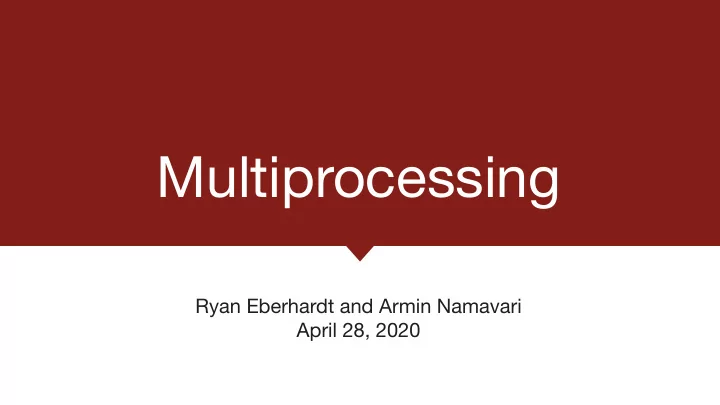

Multiprocessing Ryan Eberhardt and Armin Namavari April 28, 2020
Hello week 4! You’re killing it!! 🎊 🔦
Class logistics Week 3 exercises due Wednesday ● Please let us know if you get stuck / feel confused! We want you to ● sleep! Also, remember you can substitute any week’s exercises for a blog post ● if you’d like! First project (mini GDB) will be coming out late this week, due two weeks later ● You’ll be free to work with a partner! ● We’ll have some way for you to find someone to work with if you’d like ● (suggestions welcome) No exercise this week (just the survey) ●
This week Taking a brief break from Rust-land! ● Today: why you shouldn’t use fork(), pipe(), or signal() 🔦 🚓 ● Thursday: multiprocessing case study of Google Chrome ●
Don’t call fork()
Why fork? 🍵 Get concurrent execution (i.e. run another piece of your own program at the ● same time) Invoke external functionality on the system (i.e. run a different executable) ●
Concurrent execution How might we mess this up? (live code) ●
Concurrent execution How might we mess this up? ● Accidentally nesting forks when spawning multiple child processes ● Runaway children ● Using data structures when threads are involved ● Failure to clean up (zombie processes) ●
Concurrent execution I argue: It’s better to take the code you want to run concurrently and put it in ● a separate executable You won’t inherit data from the parent process’s virtual address space, ● but that’s the point Use arguments or pipes to provide whatever information is needed for ● the child process to run
Why fork? 🍵 Get concurrent execution (i.e. run another piece of your own program at the ● same time) Invoke external functionality on the system (i.e. run a different executable) ●
Invoking external functionality How do you start a subprocess? ● fork(), then exec() ● Almost every fork() is followed by an exec() ● Why didn’t they just make a combined syscall? ●
Child processes in Windows BOOL CreateProcessAsUserW( BOOL CreateProcessW( HANDLE hToken, LPCWSTR lpApplicationName, LPCWSTR lpApplicationName, LPWSTR lpCommandLine, LPWSTR lpCommandLine, LPSECURITY_ATTRIBUTES lpProcessAttributes, LPSECURITY_ATTRIBUTES lpProcessAttributes, LPSECURITY_ATTRIBUTES lpThreadAttributes, LPSECURITY_ATTRIBUTES lpThreadAttributes, BOOL bInheritHandles, BOOL bInheritHandles, DWORD dwCreationFlags, DWORD dwCreationFlags, LPVOID lpEnvironment, LPVOID lpEnvironment, LPCWSTR lpCurrentDirectory, LPCWSTR lpCurrentDirectory, LPSTARTUPINFOW lpStartupInfo, LPSTARTUPINFOW lpStartupInfo, LPPROCESS_INFORMATION lpProcessInformation LPPROCESS_INFORMATION lpProcessInformation ); );
fork() and exec() rationale The Unix approach is simple and powerful ● You can make any desired customizations to your child process before it ● executes the desired binary Change environment variables, rewire file descriptors, block/unblock ● signals, take control of the terminal, enable debugging, etc. Simple != easy ● malloc() and free() are simple, too! ●
Common multiprocessing tactic Let fork() and exec() be. The power is there if you need it. ● Define a higher-level abstraction to take care of the common cases ● You’re implementing one such simple abstraction in CS 110 assign3! ● Usually, these abstractions allow a “pre-exec function” to be specified, ● which is called after fork() but before exec() With such an abstraction, really no reason to call fork() or exec()! ●
Command in Rust Build a Command: ● Command::new("ps") .args(&["--pid", &pid.to_string(), "-o", "pid= ppid= command="]) Run, and get the output in a buffer: ● let output = Command::new("ps") .args(&["--pid", &pid.to_string(), "-o", "pid= ppid= command="]) .output() .expect("Failed to execute subprocess”) ● Includes exit status, stdout, and stderr
Command in Rust Run (without swallowing output), and get the status code: ● let status = Command::new("ps") .args(&["--pid", &pid.to_string(), "-o", "pid= ppid= command="]) .status() .expect("Failed to execute subprocess") Spawn and immediately return: ● let child = Command::new("ps") .args(&["--pid", &pid.to_string(), "-o", "pid= ppid= command="]) .spawn() .expect("Failed to execute subprocess") This returns a Child , which you need to wait on at some point! ● let status = child.wait()
Command in Rust Pre-exec function: ● use std::os::unix::process::CommandExt; ... let cmd = Command::new("ls"); unsafe { cmd.pre_exec(function_to_run); } let child = cmd.spawn(); The unsafe block acts as a warning to avoid allocating memory or accessing ● shared data in the presence of threads It’s quite rare that you would need to specify a pre_exec function (the Command ● API takes care of most things), but you’ll need it for Project 1
Concurrent execution How might we mess this up? ● Accidentally nesting forks when spawning multiple child processes ● Runaway children ● Using data structures when threads are involved ● Failure to clean up (zombie processes) ● You could implement a struct with a Drop trait that calls wait() ●
Don’t call pipe()
Problems with pipes What can you think of?
Problems with pipes Leaked file descriptors ● Calling close() on bad values ● Example: if (close(fds[1] == -1)) { printf("Error closing!"); } Use-before-pipe (i.e. use of uninitialized ints) ● Use-after-close ●
Potential solution Add a layer of abstraction! ● Writing to a stdin pipe: ● let mut child = Command::new("cat") .stdin(Stdio::piped()) .stdout(Stdio::piped()) .spawn()?; child.stdin.as_mut().unwrap().write_all(b"Hello, world!\n")?; let output = child.wait_with_output()?; The os_pipe crate allows for creating arbitrary pipes. (The Drop trait closes ● the pipe.)
Aside
Don’t call signal()
Is it safe? Discuss in groups ● Introduce yourself! ● See Lecture Notes on course website ●
(Continued next time)
Recommend
More recommend